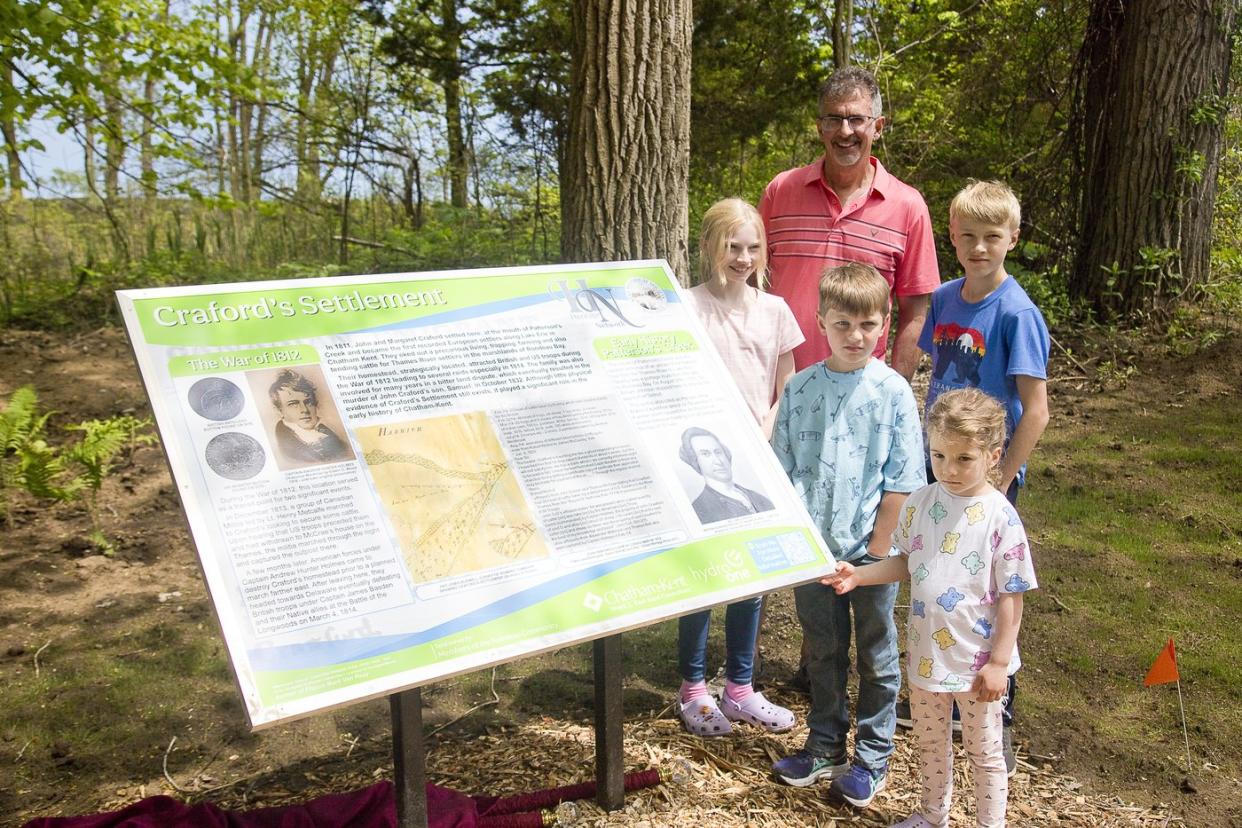Heritage Network’s plaque presentations well underway

The Chatham-Kent Heritage Network highlighted the historical significance of two local sites along the Lake Erie shoreline over the last two weekends.
Ceremonies were held in Erieau last Sunday and in Rondeau the previous weekend to unveil historical plaques commemorating the early days of both communities.
In Sunday’s ceremony, a plaque inscribed ‘Revellers and the Railroad: Erieau’s Beginnings’ was unveiled on the boulevard near the gazebo. It honours the train service and tourist trade in the 1890s that laid the foundation for the village’s identity as a summer resort community.
Cottages were already along the lakeshore when the Erie & Huron Railroad built a line into Erieau in 1894 and constructed the Bungalow Hotel, which was preceded by the Craford House and followed by the Lakeview House.
The rail line also ushered in Erieau’s era as a port for lake freighters to deliver coal from the Pennsylvania mines. The coal was loaded onto trains and transported to destinations in Kent County and southwestern Ontario.
The May 18 ceremony in Rondeau commemorated the Craford Settlement, a homestead established in 1811 by Margaret and John Craford, who, according to historians, were the first European settlers along the Lake Erie shoreline in Chatham-Kent.
A good-sized crowd was on hand for the ceremony and plaque unveiling, which took place at the end of Bates Drive near the mouth of Patterson Creek (now known as the Ross Drain), where the Crafords established their settlement over 200 years ago.
Local historian Mark Van Raay took the audience back in time and explained the area was first used as a camping ground for First Nations and early European explorers.
It was also the site where the Wilkins Expedition, a flotilla of ships on their way to relieve the British under siege at Fort Detroit in 1763, was lost in a storm on Lake Erie off Patterson Creek.
The Crafords moved to the area from the Wallacetown area in 1811 and cleared 10 acres of land to set up a cattle farm.
When the War of 1812 broke out, the Craford homestead was a transit point for the Canadian militia. It was also a site for settlers along the Thames River to bring their cattle for safekeeping from the invading Americans.
However, after winning the Battle of the Thames in the fall of 1813, the Americans raided the Craford homestead and stole cattle.
The British militia showed up shortly after looking for cattle themselves. Upon learning of the Americans’ thievery, they marched to the McCrae House, west of Chatham on the Thames River, and recaptured the post.
The Amercians returned to the Craford homestead in 1814 to steal more cattle on their way inland towards the Thames River, where they defeated the British in the Battle of Longwoods.
The Craford Settlement burned to the ground later in 1814.
“This has been a neglected place in history in Rondeau and Chatham-Kent until today,” Van Raay told the audience. “I really want to thank you for all coming out and helping to build awareness of this place, which is something special.”
Van Raay, whose research is depicted on the colourful plaque, thanked the residents, many of whom asked to be anonymous, for helping finance the project.
The Craford and Erieau plaques are the third and fourth erected by the Chatham-Kent Heritage Network, established by local historians Jim and Lisa Gilbert in collaboration with the Municipality of Chatham-Kent and other historical organizations.
The first plaque was placed in Stirling Park in Chatham last fall to honour the 1934 Colored All-Star team. The team was forced to play on the route to their historic Ontario Baseball Association championships because it was not allowed to play on the city’s main diamond, what is now Fergie Jenkins Field at Rotary Park.
The second plaque was erected earlier this spring on the former Ferguson Opera House site in Thamesville, which was located where the Bank of Montreal stands on Victoria Road south of the London Road intersection.
A dedication ceremony was held on April 28 to celebrate the Ferguson family, who constructed a two-storey brick building with offices and stores on the main floor and a 400-seat theatre on the upper level.
The venue drew top-notch performers and was the focal point in the area when Thamesville was at the height of its prosperity.
The Heritage Network’s plaque project is mainly supported financially through the Hydro One Community Fund, which Mayor Darrin Canniff and councillors administer for projects in their wards.
Lisa Gilbert said fundraising and sponsorship are also conducted within each community where plaques are placed.
The Heritage Network connects with organizations within each community for input to determine the significant historical period to be recognized with a plaque.
“This group was formed specifically to get this plaque initiative underway,” Gilbert told the audience. “It is a group that has really been needed.”
“Chatham-Kent is the size of a small European country, and it is important that the people at one end of the municipality get to know the people at the other end of the community and every place in between,” she said.
Three more plaques will be unveiled next month – commemorating the Baptiste Creek Train Disaster in Jeannette’s Creek on June 8, the former Commercial Fishing industry in Mitchell’s Bay on June 24 and the Glass Factory in Wallaceburg on June 29.
Gilbert said the Heritage Network is working with local history buffs on a plaque idea and location for Ridgetown. The plaque will likely be installed in 2026 to avoid conflicting with the town’s 150th anniversary celebration in 2025.
Michael Bennett, Local Journalism Initiative Reporter, The Ridgetown Independent News


